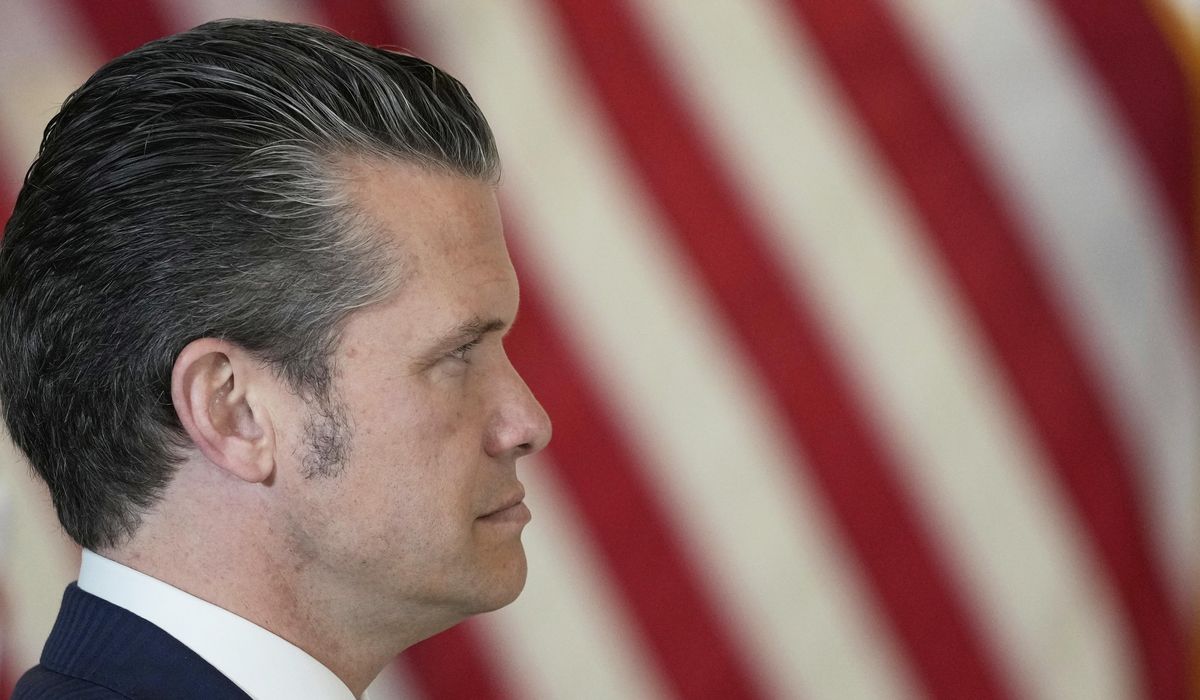


ANALYSIS:
The deployment of active-duty Marines to Los Angeles to help quell widespread and sometimes violent immigration raid protests could turn into a pivotal moment for the two men President Trump has put atop the U.S. military: Defense Secretary Pete Hegseth and Joint Chiefs of Staff Chairman Gen. Dan Caine.
National security analysts and military insiders are quick to point out that, should the deployment of National Guard forces and about 700 Marines help extinguish the chaotic situation in southern California quickly and with no loss of life, there’s little apparent risk of political fallout for either Mr. Hegseth or Gen. Caine. In fact, so far Mr. Hegseth has seemingly leaned into the immigration fight with left-leaning California officials, broaching the possibility of active-duty deployments last weekend, days before the president gave the order. And Mr. Hegseth defended the moves Tuesday during a contentious back-and-forth with House lawmakers.
But the tense, volatile situation in Los Angeles in some ways conjures memories of the last time Mr. Trump faced significant and politically charged public protests: The summer of 2020, following the murder of George Floyd, a Black man, at the hands of Minneapolis police.
The subsequent demonstrations in Washington had immediate impacts on Mr. Trump’s relationship with then-Defense Secretary Mark Esper, who publicly pushed back on the idea that Mr. Trump should invoke the Insurrection Act and send in active-duty troops to deal with the protests. And it marked the beginning of the unraveling of Mr. Trump’s relationship with then-Joint Chiefs Chairman Gen. Mark A. Milley, who publicly apologized after walking onto the streets of Washington in his uniform alongside the president during the height of the 2020 unrest.
Neither Mr. Hegseth nor Mr. Caine appears likely to break with the administration in any way that’s comparable to those incidents in 2020. Specialists say the most important consideration now is that the American troops on the ground in the nation’s second-largest city do not cause any deaths or injuries to protesters.
“So far, I am nervous but not anxious. The key is to avoid casualties,” Michael O’Hanlon, senior fellow and director of research in foreign policy at the Brookings Institution, told The Washington Times.
Mr. Hegseth defended the deployment of Marines and told lawmakers Tuesday that National Guard and reserve forces could be used again in the future.
“I think we’re entering another phase, especially under President Trump with his focus on the homeland, where the National Guard and reserves become a critical component of how we secure that homeland,” he said.
Mr. Hegseth has come under intense fire from Democrats. The criticism is sure to ramp up even further after the Pentagon revealed Tuesday that the Los Angeles deployment will cost at least $134 million.
“Since our nation’s founding, the American people have been perfectly clear: we do not want the military conducting law enforcement on U.S. soil,” Sen. Jack Reed, Rhode Island Democrat and ranking member on the Senate Armed Services Committee, said in a statement late Monday.
“President Trump must stop testing the boundaries of the executive branch’s power and attempting to use the military domestically,” Mr. Reed said.
Democrats were highly critical of military leaders in the summer of 2020, too. But analysts say there’s another crucial difference today: So far at least, neither Mr. Hegseth nor Gen. Caine have appeared in Los Angeles and put themselves in the middle of the situation.
“What makes it very different is the senior leaders are not personally involved. If Hegseth and Caine were actually out there, standing there with the National Guard or something, then you’d get some of the flavor we had back in 2020. But that’s not the case here,” said Mark Cancian, a senior adviser at the Center for Strategic and International Studies and a retired Marine Corps colonel.
“A big difference is they are not personally on the ground and involved,” Mr. Cancian said in an interview. “And Caine would be in the same position Milley was in — it would be very fraught for him. But that’s not the case.”
Indeed, the episode in Washington in the summer of 2020 became one of the defining moments of Mr. Milley’s tenure as the nation’s top uniformed officer. As the Washington protests raged, Mr. Milley accompanied Mr. Trump out of the White House on a now-infamous walk through Lafayette Square.
The general later apologized amid criticism that his involvement created the perception that the military was involved in politics.
“I should not have been there,” Mr. Milley said at the time.
Mr. Milley stayed on as Joint Chiefs chairman for the remainder of Mr. Trump’s time in office, though their relationship soured and the now-retired general has become one of the president’s most frequent targets.
The situation also seemed to mark a break between Mr. Esper and the president.
Two days after the Lafayette Square incident, the then-Pentagon chief publicly pushed back on the possibility that Mr. Trump could invoke the 1807 Insurrection Act, which would enable the president to deploy active-duty troops to help squash demonstrations.
“The option to use active-duty forces in a law enforcement role should only be used as a matter of last resort and only in the most urgent and dire of situations. We are not in one of those situations now,” Mr. Esper said on June 3, 2020, during brief remarks at the Pentagon. “I do not support invoking the Insurrection Act.”
• Ben Wolfgang can be reached at bwolfgang@washingtontimes.com.
